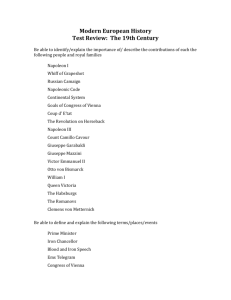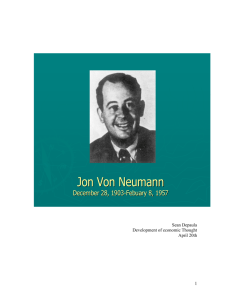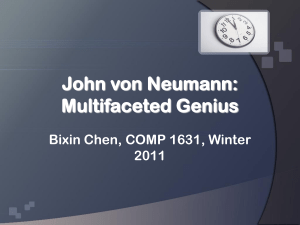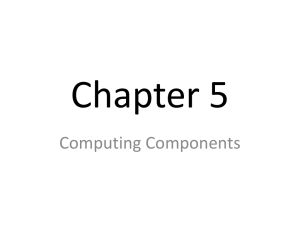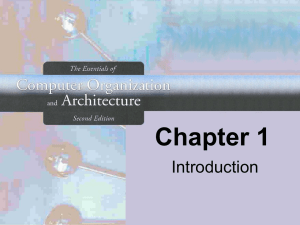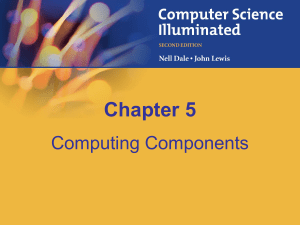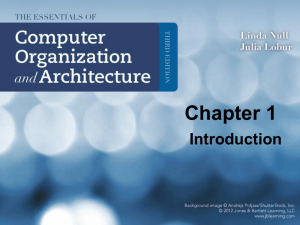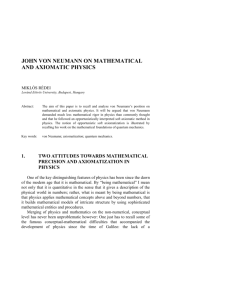Report on “The Impacts of the Early Twentieth Century Physics and
advertisement
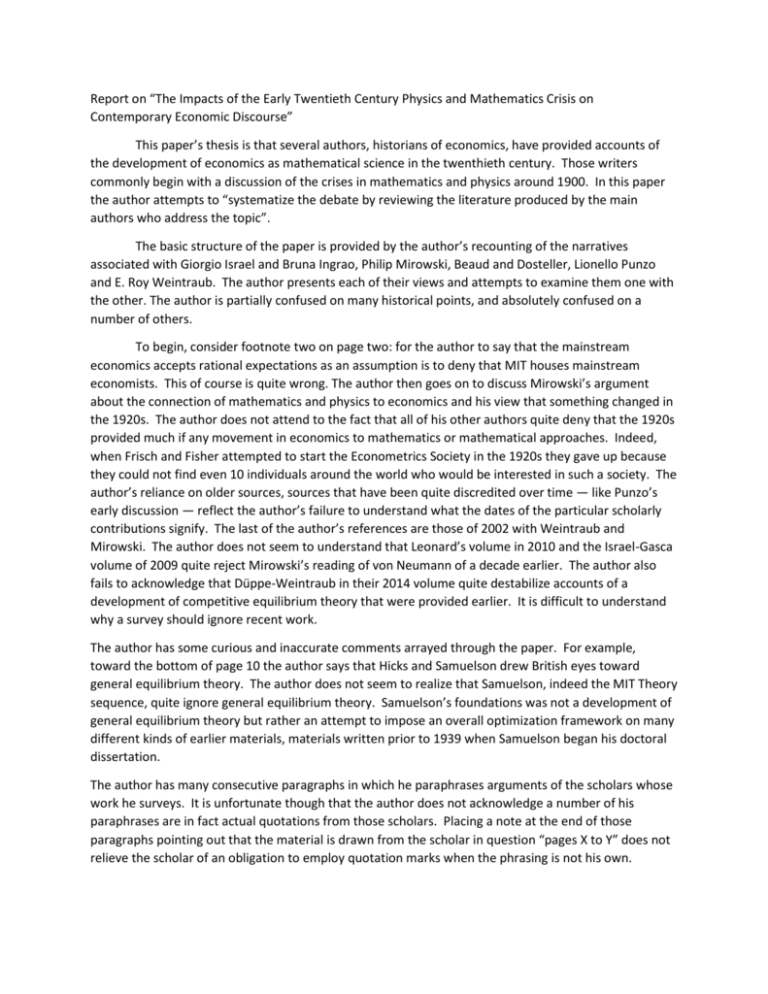
Report on “The Impacts of the Early Twentieth Century Physics and Mathematics Crisis on Contemporary Economic Discourse” This paper’s thesis is that several authors, historians of economics, have provided accounts of the development of economics as mathematical science in the twenthieth century. Those writers commonly begin with a discussion of the crises in mathematics and physics around 1900. In this paper the author attempts to “systematize the debate by reviewing the literature produced by the main authors who address the topic”. The basic structure of the paper is provided by the author’s recounting of the narratives associated with Giorgio Israel and Bruna Ingrao, Philip Mirowski, Beaud and Dosteller, Lionello Punzo and E. Roy Weintraub. The author presents each of their views and attempts to examine them one with the other. The author is partially confused on many historical points, and absolutely confused on a number of others. To begin, consider footnote two on page two: for the author to say that the mainstream economics accepts rational expectations as an assumption is to deny that MIT houses mainstream economists. This of course is quite wrong. The author then goes on to discuss Mirowski’s argument about the connection of mathematics and physics to economics and his view that something changed in the 1920s. The author does not attend to the fact that all of his other authors quite deny that the 1920s provided much if any movement in economics to mathematics or mathematical approaches. Indeed, when Frisch and Fisher attempted to start the Econometrics Society in the 1920s they gave up because they could not find even 10 individuals around the world who would be interested in such a society. The author’s reliance on older sources, sources that have been quite discredited over time — like Punzo’s early discussion — reflect the author’s failure to understand what the dates of the particular scholarly contributions signify. The last of the author’s references are those of 2002 with Weintraub and Mirowski. The author does not seem to understand that Leonard’s volume in 2010 and the Israel-Gasca volume of 2009 quite reject Mirowski’s reading of von Neumann of a decade earlier. The author also fails to acknowledge that Düppe-Weintraub in their 2014 volume quite destabilize accounts of a development of competitive equilibrium theory that were provided earlier. It is difficult to understand why a survey should ignore recent work. The author has some curious and inaccurate comments arrayed through the paper. For example, toward the bottom of page 10 the author says that Hicks and Samuelson drew British eyes toward general equilibrium theory. The author does not seem to realize that Samuelson, indeed the MIT Theory sequence, quite ignore general equilibrium theory. Samuelson’s foundations was not a development of general equilibrium theory but rather an attempt to impose an overall optimization framework on many different kinds of earlier materials, materials written prior to 1939 when Samuelson began his doctoral dissertation. The author has many consecutive paragraphs in which he paraphrases arguments of the scholars whose work he surveys. It is unfortunate though that the author does not acknowledge a number of his paraphrases are in fact actual quotations from those scholars. Placing a note at the end of those paragraphs pointing out that the material is drawn from the scholar in question “pages X to Y” does not relieve the scholar of an obligation to employ quotation marks when the phrasing is not his own. The central problem of the paper is that the author is totally confused about the idea of formalization. The author conflates Hilbert’s formalist program with discussions of Gödel, and the incompleteness theorem with ideas of axiomatization. The move from there to von Neumann and to Vienna is not well understood by the author. It would have been useful for the author to take more account of work on Hilbert by historians of mathematics and mathematical philosophy which conclude that talk of Hilbert’s formalist program makes no sense. Attempts by Corry and Weintraub and others to link Hilbert’s ideas back to his 1900 mathematics congress paper on unsolved problems does a better job of providing an alternative way of thinking about this. Historians of philosophy and metamathematics are not in fact good historians. This can be seen for example in the third paragraph on page 15 when the author talks about the development of non-Euclidian geometry in the early years of the 20th century. In fact those developments in mathematics occurred in the last third of the nineteenth century so that the author’s statement that “at about the same time, development of non-Euclidian geometry…” In a similar vein the author is confused about the crises in physics. The author mentions a number of times the “new model based on quantum physics” without stating what this new model consisted of, or how it affected anything. Is the author referring to black body radiation questions? It also seems the author has this mixed up with relativity theory which is of course not helpful. The author’s insistence on the distinction between the “empirical-deductive method” and the “hypothetical-deductive method” seems quite forced. The author seems to refer to unpublished work by Bresser-Pereira that employs such a distinction. It is difficult to understand what a difference this distinction makes. Mill’s arguments about economic logic, and those of John Neville Keynes, as well as continuous work in the methodology of economics, suggest that these kinds of philosophical ideal types are not to be found in economic practice. However the largest set of historically inaccurate statements occurs around the author’s use of the term “Vienna Circle”. Quite simply, the author appears not to understand that “the Vienna Circle” (der Wiener Kreis) and the “Mathematical Colloquium” (der Menger Kreis) are entirely different discussion groups. The former involved philosophers, the latter mathematicians. The discussion of Hilbert’s formalist program was not part of the Vienna Circle. The mathematical logicians in the Menger Kreis, Gödel included, von Neumann included as a visitor on occasion, were involved in the Mathematical Colloquium. Worse the author does not seem to realize that von Neumann had already set up operations in the United States by 1932 and was no longer affiliated formally with any European institution. Section 1.34 on General Equilibrium in the Vienna Circles continues this wrong-headed argument. The Vienna Circle, though associated with Moritz Schlick and Otto Neurath and others had no interest whatsoever in general equilibrium theory. It was the Menger mathematical colloquium that discussed several different papers by Schlesinger and Wald in the early 1930s. On page 19 it was not the case that “the circle reexamined Walras’ [in any event it was Cassell’s, not Walras’] general equilibrium model”. The circle did no such thing. And at the bottom of that page, John von Neumann was never a participant of the Vienna Circle. As a result, the claim at the bottom on the first paragraph on page 20 that “the point of convergence between von Neumann and the Vienna Circle is the proof of logical consistency of the general equilibrium model” is nonsense, and has been repudiated by Punzo who wrongly suggested that to be the case several decades ago. These kinds of misunderstandings get reflected on for example page 22 when the author claims that von Neumann’s main contribution to economics “…emerged from the discussion of HIlbert’s formalist program of the 1920s…” It is hard to see what the author describes as Hilbert’s formalist program in any manifestation of the von Neumann paper, even with the similarity of some elements of von Neumann’s 1927 paper on the theory of games. These kinds of problems ramify. For example on the top of page 23 the author claims that Morgenstern’s concerns were associated with creating “a new mathematical language”. There’s nothing that could be further from the case, as Morgenstern had no such concern - he was an economist not a mathematician. The concern of course was von Neumann’s. The author then continues with a claim that von Neumann and Morgenstern’s book axiomatized economics. It is hard to understand whether the author has even read von Neumann and Morgenstern for such a claim is neither made nor developed. What was axiomatized in the second edition, at Morgenstern’s insistence, were the axioms for behavior, not axioms for economics. These kinds of confusions about formalism, the Vienna Circle, Hilbert’s formalist program, ultimately make Bourbaki opaque. For example the author in the first full paragraph on page 29 argues that after Cowles moved to Yale, “which had the biggest economics department in the U.S. at the time”, the move “helped disseminate Bourbaki’s ideas to other economics departments in the United States and worldwide.” It is impossible to see how this occurred. First, Yale did not have the largest economics department – where the author came up with this is a mystery. Second, Debreu was denied tenure at Yale, because his book, The Theory of Value, was judged by his colleagues there to be insufficiently connected with economics. Debreu was quite isolated at Yale, talking not with any of the economists but instead with the mathematician Kakutani. A larger point emerges from consideration of this paper. I refer to the failure of scholars to take seriously the notion that the history of economic science cannot be re-written from the ground up every year. Scholars necessarily rely on the work of other scholars and build upon and correct their ideas. As a result, rather than ordering the author’s scholars accounts by topic, had the author taken more seriously the sequence of dates at which they were writing he would have noticed a pattern that earlier claims had been evaluated, and for the most part, refined or corrected or repudiated in subsequent accounts. Thus to take Punzo’s accounts as standing in a symmetric position with those of Mirowski, or of Weintraub’s, is to perform historiographic legerdemain. It is difficult to understand what contribution this paper claims to make. It is only when one gets to the final sentence, “this is a subject of our second essay”, that we understand the source of the author’s difficulty. This article must have been an initial survey of the literature chapter to a thesis or dissertation. It is not thus a contribution to any historical literature. As a thesis chapter it must have been constructed to satisfy thesis advisors’ expectations that the author has read background materials and is familiar with the secondary literature of some question. There is no evidence though that the author has encountered or read any of the primary literature. As a result, I cannot recommend publication of this paper nor do I see any path to revision that would make it acceptable for the History of Political Economy.
